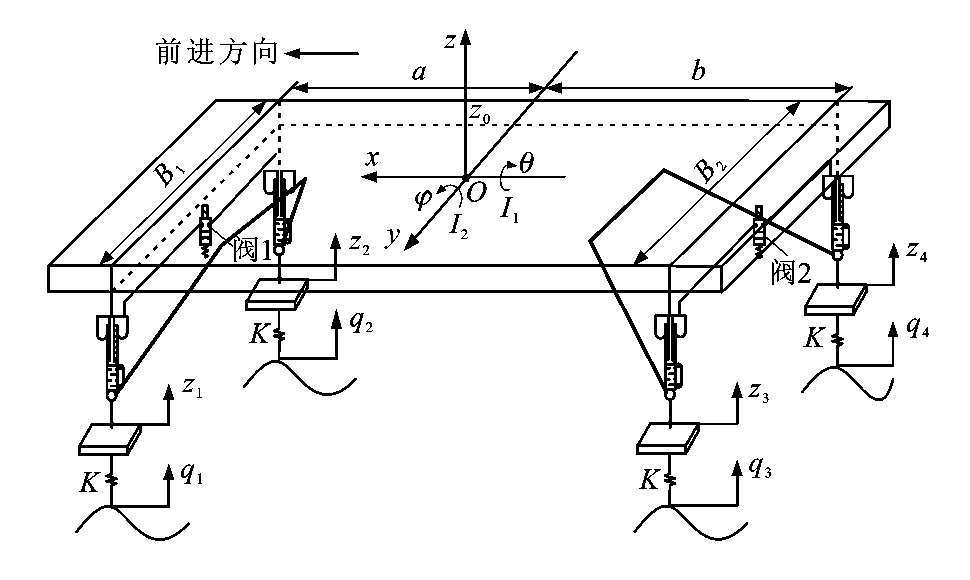Game control of multi-agent damper system for laterally interconnected air suspension
Article Text (Baidu Translation)
-
摘要: 为进一步改善横向互联空气悬架车辆的行驶平顺性和操纵稳定性, 基于多智能体理论和合作博弈Shapley值原理构建多智能体减振器控制系统; 多智能体减振器控制系统由信息发布智能体、平顺性智能体、操稳性智能体和博弈协调智能体组成, 其中信息发布智能体从环境中获取车辆状态信息, 根据下层智能体的信息需求传递信息, 平顺性智能体接收悬架动行程及其变化率信息, 根据平顺性控制要求, 输出自身的阻尼系数意图, 操稳性智能体接收当前互联状态信息触发对应的推理模块, 根据车身侧倾角信息求解需求的阻尼系数, 其中推理模块是通过对遗传算法优化出的阻尼系数进行模糊神经网络自学习形成的, 博弈协调智能体接收平顺性智能体与操稳性智能体的阻尼意图, 根据自身的合作博弈规则, 对阻尼意图进行修正, 输出全局最优阻尼系数; 在不同互联状态、不同激励条件下进行空气悬架静、动态特性试验研究, 并将试验结果与仿真结果进行对比, 验证仿真模型的准确性; 在混合工况下, 利用整车仿真模型验证多智能体减振器控制系统的可行性和有效性。研究结果表明: 和传统减振器阻尼控制系统相比, 多智能体减振器控制系统能有效地使簧载质量加速度均方根值降低14.95%, 悬架动行程均方根值降低10.64%, 车身侧倾角均方根值降低12.33%。提出的多智能体减振器控制系统改善了车辆行驶平顺性和乘坐舒适性, 并且能够抑制车身的侧倾, 提高整车的操纵稳定性。Abstract: To further improve the ride comfort and handling stability of vehicles equipped with laterally interconnected air suspension (LIAS), on the basis of multi-agent theory and the cooperative game Shapley value principle, a multi-agent damper control system was constructed.The multi-agent vibration absorber control system was composed of an information publishing agent, ride comfort agent, handling stability agent, and game cooperation agent.The vehicle state information from the environment was obtained by the information publishing agent, and the information transmission was finished according to the information demand of the lower agent.The suspension dynamic travel and its changing rate information were received by the ride comfort agent, and its own damping coefficient intention was output according to the ride control requirements.The information of the current interconnected state was received by the handlingstability agent, the corresponding reasoning module was triggered, and the required damping coefficient was solved according to the information of the carbody roll angle.The reasoning module was formed by fuzzy neural network self-learning to the damping coefficient optimized by agenetic algorithm.The damping intents of the ride comfort agent and handling stability agent were received by the game cooperation agent, the damping intents were modified according to its own cooperative game rules, and the global optimal damping coefficient was outputted.Under different interconnected states and different excitation conditions, the static and dynamic characteristics of the air suspension were tested and compared with the simulation results, and the accuracy of the simulation model was verified.Under the condition of mixed construction, the feasibility and effectiveness of the multi-agent damper control system were verified by a vehicle simulation model.Analysis result shows that compared with the traditional damping control system, the multi-agent damper control system can effectively reduce the RMS values of the sprung mass acceleration, the suspension dynamic travel and the body roll angle by 14.95%, 10.64%and 12.33%, respectively.Therefore, the proposed system not only improves the ride stationarity and comfort, but also restrains the car's side inclination and improves the handling stability of the whole vehicle.
-
表 1 样车参数
Table 1. Parameters of model car

-
[1] DAVIS L, BUNKER J. Dynamic load sharing in heavy vehicle suspensions[J]. Modern Traffic and Transportation Engineering Research, 2014, 3 (1): 1-6. [2] ESKANDARY P K. Interconnected air suspensions with independent height and stiffness tuning[D]. Waterloo: University of Waterloo, 2014. [3] 江洪, 杨勇福, 余鹏飞, 等. 气路闭环横向互联空气悬架车身高度调节[J]. 北京航空航天大学学报, 2015, 41 (11): 2010-2016. https://www.cnki.com.cn/Article/CJFDTOTAL-BJHK201511005.htmJIANG Hong, YANG Yong-fu, YU Peng-fei, et al. Vehicle height adjustment of closed-loop air circuit laterally interconnected air suspension system[J]. Journal of Beijing University of Aeronautics and Astronautics, 2015, 41 (11): 2010-2016. (in Chinese). https://www.cnki.com.cn/Article/CJFDTOTAL-BJHK201511005.htm [4] ZHU Sang-zhi, WANG Li-fu, ZHANG Nong, et al. H∞control of a novel low-cost roll-plane active hydraulically interconnected suspension: an experimental investigation of roll control under ground excitation[J]. SAE International Journal of Passenger Cars—Mechanical Systems, 2013, 6 (2): 882-893. doi: 10.4271/2013-01-1238 [5] KAT C J, ELS P S. Interconnected air spring model[J]. Mathematical and Computer Modelling of Dynamical Systems, 2009, 15 (4): 353-370. doi: 10.1080/13873950902955783 [6] WOLF-MONHEIM F, SCHUMACHER M, FRANTZEN M, et al. Interlinked air suspension systems[J]. ATZautotechnology, 2009, 9 (3): 58-61. doi: 10.1007/BF03247122 [7] WOLF-MONHEIM F, FRANTZEN M, SEEMANN M, et al. Modeling, testing and correlation of interlinked air suspension systems for premium vehicle platforms[C]//FISITA. Proceedings of 23th World Automotive Congress. London: FISITA, 2008: 1-8. [8] DAVIS L, BUNKER J. Altering heavy vehicle air suspension dynamic forces by modifying air lines[J]. International Journal of Heavy Vehicle Systems, 2011, 18 (1): 1-17. doi: 10.1504/IJHVS.2011.037957 [9] 李重重. 附加气室容积可调空气悬架刚度和阻尼控制[D]. 镇江: 江苏大学, 2016.LI Zhong-zhong. Stiffness and damping control of air suspension with adjustable volumes of auxiliary chamber[D]. Zhenjiang: Jiangsu University, 2016. (in Chinese). [10] CHEN Yi-kai, HE Jie, KING M, et al. Model development and dynamic load-sharing analysis of longitudinal-connected air suspensions[J]. Journal of Mechanical Engineering, 2013, 59 (1): 14-24. doi: 10.5545/sv-jme.2012.755 [11] CHEN Yi-kai, HE Jie, KING M, et al. Effect of driving conditions and suspension parameters on dynamic load-sharing of longitudinal-connected air suspensions[J]. Science China Technological Sciences, 2013, 56 (3): 666-676. doi: 10.1007/s11431-012-5091-3 [12] HASSAN M Z, AZIZ M K H A, DELBRESSINE F, et al. Numerical analysis of spring stiffness in vehicle design development stage[J]. International Journal of Applied Engineering Research, 2016, 11 (7): 5163-5168. http://www.idemployee.id.tue.nl/g.w.m.rauterberg/publications/IJAER2016journal.pdf [13] 李仲兴, 崔振, 徐兴, 等. 互联式空气悬架动态特性试验研究[J]. 科学技术与工程, 2014, 14 (14): 82-86. doi: 10.3969/j.issn.1671-1815.2014.14.016LI Zhong-xing, CUI Zhen, XU Xing, et al. Experimental study on dynamic characteristics of interconnected air suspension[J]. Science Technology and Engineering, 2014, 14 (14): 82-86. (in Chinese). doi: 10.3969/j.issn.1671-1815.2014.14.016 [14] LI Zhong-xing, JU Long-yu, JIANG Hong, et al. Experimental and simulation study on the vibration isolation and torsion elimination performances of interconnected air suspensions[J]. Proceedings of the Institution of Mechanical Engineers, Part D: Journal of Automobile Engineering, 2016, 230 (5): 679-691. doi: 10.1177/0954407015591664 [15] 钱宽. 互联空气悬架动态特性及对整车振动性能影响分析[D]. 镇江: 江苏大学, 2016.QIAN Kuan. Analysis on dynamic characteristics of interconnected air suspension and its effects on full vehicle vibration performance[D]. Zhenjiang: Jiangsu University, 2016. (in Chinese). [16] 李仲兴, 于文浩, 刘亚威, 等. 横向互联空气悬架动侧倾角刚度特性[J]. 华中科技大学学报: 自然科学版, 2017, 45 (9): 76-82. https://www.cnki.com.cn/Article/CJFDTOTAL-HZLG201709014.htmLI Zhong-xing, YU Wen-hao, LIU Ya-wei, et al. Dynamic rolling stiffness characteristic of laterally interconnected air suspension[J]. Journal of Huazhong University of Science and Technology: Natural Science Edition, 2017, 45 (9): 76-82. (in Chinese). https://www.cnki.com.cn/Article/CJFDTOTAL-HZLG201709014.htm [17] 琚龙玉. 横向互联空气悬架特性及仿天棚互联状态控制理论研究[D]. 镇江: 江苏大学, 2016.JU Long-yu. Dynamic characteristic analysis and intimatied skyhook control theory of laterally interconnected air suspension[D]. Zhenjiang: Jiangsu University, 2016. (in Chinese). [18] 崔振. 半主动横向互联空气悬架的特性及其分层控制研究[D]. 镇江: 江苏大学, 2014.CUI Zhen. Study on the performance of semi-active laterally interconnected air suspension and its hierarchical control[D]. Zhenjiang: Jiangsu University, 2014. (in Chinese). [19] 王向华, 陈特放. 智能体技术在公交调度系统中的应用[J]. 中南大学学报: 自然科学版, 2013, 44 (8): 3539-3545. https://www.cnki.com.cn/Article/CJFDTOTAL-ZNGD201308061.htmWANG Xiang-hua, CHEN Te-fang. Application of intelligent public transportation dispatch system based on agent[J]. Journal of Central South University: Scienceand Technology, 2013, 44 (8): 3539-3545. (in Chinese). https://www.cnki.com.cn/Article/CJFDTOTAL-ZNGD201308061.htm [20] TAO Xue-li, ZHENG Yan-bin. A level task allocation method for multiple-agents[J]. Journal of Computational Information Systems, 2013, 9 (2): 813-820. [21] XYDAS E, MARMARAS C, CIPICIGAN L M. A multiagent based scheduling algorithm for adaptive electric vehicles charging[J]. Applied Energy, 2016, 177 (1): 354-365. [22] ALAVI S M, ZHOU C. Resource allocation scheme for orthogonal frequency division multiple access networks based on cooperative game theory[J]. International Journal of Communication Systems, 2015, 27 (8): 1105-1125. [23] KARNOPP D, CROSBY M J, HARDWOOD R A. Vibration control using semi-active force generators[J]. Journal of Engineering for Industry, 1975, 96 (2): 619-626. [24] PARK J H, KIM W H, SHIN C S, et al. A comparative work on vibration control of a quarter car suspension system with two different magneto-rheological dampers[J]. Smart Material Structures, 2017, 26 (1): 1-10. [25] 汪洪波, 陈无畏, 杨柳青, 等. 基于博弈论和功能分配的汽车底盘系统协调控制[J]. 机械工程学报, 2012, 48 (22): 105-112. https://www.cnki.com.cn/Article/CJFDTOTAL-JXXB201222019.htmWANG Hong-bo, CHEN Wu-wei, YANG Liu-qing, et al. Coordinated control of vehicle chassis system based on game theory and function distribution[J]. Journal of Mechanical Engineering, 2012, 48 (22): 105-112. (in Chinese). https://www.cnki.com.cn/Article/CJFDTOTAL-JXXB201222019.htm [26] 李勇. 基于动作的多智能体系统时态认知逻辑模型检测[D]. 泉州: 华侨大学, 2016.LI Yong. Model checking action-based temporal epistemic logic for multi-agent systems[D]. Quanzhou: Huaqiao University, 2016. (in Chinese). [27] HU Jun-jie, MORAIS H, LIND M, et al. Multi-agent based modeling for electric vehicle integration in a distribution network operation[J]. Electric Power Systems Research, 2016, 136: 1-26. doi: 10.1016/j.epsr.2016.01.018 [28] CONTE G, SCARADOZZI D, MANNOCCHI D, et al. Development and experimental tests of a ROS multi-agent structure for autonomous surface vehicles[J]. Journal of Intelligent and Robotic Systems, 2017 (14): 1-14. [29] 牛礼民, 叶李军, 阮晓东. 混合动力汽车多能源动力总成的智能体控制技术[J]. 上海交通大学学报, 2015, 49 (8): 1108-1113, 1122. https://www.cnki.com.cn/Article/CJFDTOTAL-SHJT201508006.htmNIU Li-min, YE Li-jun, RUAN Xiao-dong. Agent control technology for hybrid electric vehicle multi-energy powertrain[J]. Journal of Shanghai Jiaotong University, 2015, 49 (8): 1108-1113, 1122. (in Chinese). https://www.cnki.com.cn/Article/CJFDTOTAL-SHJT201508006.htm [30] 刘岳鹏. 基于BDI的管制员Agent建模技术[D]. 南京: 南京航空航天大学, 2016.LIU Yue-peng. Research on the ATC agent modeling based on BDI model[D]. Nanjing: Nanjing University of Aeronautics and Astronautics, 2016. (in Chinese). [31] 李仲兴, 李重重, 刘亚威, 等. 半主动悬架系统刚度动态迭代跟踪控制[J]. 中南大学学报: 自然科学版, 2017, 48 (5): 1204-1210. https://www.cnki.com.cn/Article/CJFDTOTAL-ZNGD201705012.htmLI Zhong-xing, LI Zhong-zhong, LIU Ya-wei, et al. Dynamic and trackable interation controls on stiffness of semi-active suspension system[J]. Journal of Central South University: Science and Technology, 2017, 48 (5): 1204-1210. (in Chinese). https://www.cnki.com.cn/Article/CJFDTOTAL-ZNGD201705012.htm -





 下载:
下载:

















